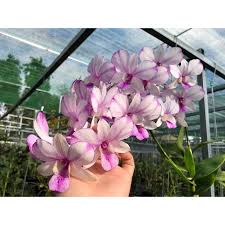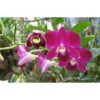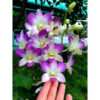# Optimizing Light for Dendrobium Orchids Indoors

Dendrobium orchids, known for their stunning flowers and diverse varieties, are a favorite among plant enthusiasts. While these orchids are relatively easy to care for, one of the most crucial aspects of their growth is light. Proper lighting can significantly impact their health, flowering, and overall vitality. This comprehensive guide will delve into how to optimize light for Dendrobium orchids indoors, ensuring they thrive and flourish in your home.
## 1. Understanding Dendrobium Orchids and Their Light Requirements
### 1.1 What Are Dendrobium Orchids?
Dendrobium orchids belong to the Dendrobium genus, which comprises more than 1,800 species. These orchids are native to tropical and subtropical regions of Asia, Australia, and the Pacific Islands. They are known for their varied growth habits and beautiful, often fragrant flowers.
### 1.2 Natural Light Conditions
In their natural habitat, Dendrobium orchids thrive in bright, indirect sunlight. They typically grow in trees, benefiting from filtered light. Therefore, mimicking these conditions indoors is vital for their successful growth. Dendrobium orchids generally require:
– **Bright Indirect Light**: Ideal conditions provide bright, filtered light for 6 to 8 hours a day.
– **Avoid Direct Sunlight**: Direct sunlight can scorch the leaves and flowers, leading to stress and damage.
## 2. Assessing Your Indoor Light Conditions
### 2.1 Evaluating Natural Light
Before optimizing your indoor lighting for Dendrobium orchids, assess the natural light available in your space:
– **Window Orientation**: Different window orientations receive varying amounts of light. South-facing windows typically provide the most light, while north-facing windows receive the least.
– **Room Size and Layout**: Consider how the size and layout of your room impact light availability. Larger rooms may require more light sources.
### 2.2 Measuring Light Intensity
To understand how much light your orchids are receiving, you can measure light intensity using a light meter. This device helps you determine if the light levels are suitable for your Dendrobium orchids. Ideal light levels for these orchids range from 2,000 to 3,000 foot-candles.
## 3. Creating the Ideal Lighting Environment
### 3.1 Selecting the Right Location
Based on your assessment, choose the best location for your Dendrobium orchids:
– **Near a Window**: Place your orchids near a window that receives bright, indirect light. South or east-facing windows are typically ideal.
– **Avoid Dark Corners**: Orchids placed in dark corners or far from natural light sources may struggle to thrive.
### 3.2 Using Sheer Curtains or Blinds
If your orchids are placed in direct sunlight, consider using sheer curtains or blinds to diffuse the light. This will help provide the bright, indirect light that Dendrobium orchids crave while protecting them from harsh rays.
### 3.3 Rotating Your Orchids
To ensure even light exposure, rotate your Dendrobium orchids every few weeks. This practice helps prevent the plants from leaning toward the light source, promoting balanced growth.
## 4. Supplementing Natural Light with Artificial Lighting
### 4.1 Understanding Artificial Lighting Options
If natural light is insufficient, especially during the winter months or in low-light environments, consider supplementing with artificial lights. Here are some popular options:
– **LED Grow Lights**: Energy-efficient and long-lasting, LED grow lights emit specific wavelengths of light beneficial for plant growth. They can be adjusted in intensity and distance from the plants.
– **Fluorescent Lights**: These lights are effective for growing orchids. Full-spectrum fluorescent bulbs provide a balanced spectrum of light that closely mimics natural sunlight.
– **Incandescent Lights**: While not ideal for orchids, incandescent bulbs can be used in a pinch. However, they generate heat, which can be harmful if placed too close to the plants.
### 4.2 Determining Light Duration
Dendrobium orchids require approximately 12 to 14 hours of light per day. When using artificial lighting, set timers to ensure a consistent light schedule:
– **Morning to Evening**: Aim for a light cycle that mimics natural sunlight patterns, turning lights on in the morning and off in the evening.
– **Consistency is Key**: Maintaining a consistent light schedule helps your orchids adapt and thrive.
### 4.3 Placement of Artificial Lights
When using artificial lights, consider their placement:
– **Distance**: Place grow lights 12 to 24 inches above the orchids, depending on the light’s intensity. Adjust the height based on the plants’ response to the light.
– **Angle**: Direct the lights at an angle that mimics sunlight. This can help distribute light evenly across the plant.
## 5. Monitoring and Adjusting Light Conditions
### 5.1 Observing Plant Response
Regularly observe your Dendrobium orchids for signs of stress or inadequate lighting:
– **Leaf Color**: Healthy Dendrobium leaves should be a vibrant green. Yellowing leaves may indicate insufficient light, while brown, scorched leaves suggest too much direct light.
– **Growth Patterns**: Stretched or leggy growth can indicate insufficient light, while compact growth usually signifies adequate light levels.
### 5.2 Adjusting Light Conditions
Based on your observations, adjust the lighting conditions as needed:
– **Increase Light Exposure**: If orchids appear leggy or have yellowing leaves, consider moving them closer to a light source or increasing the duration of artificial lighting.
– **Reduce Light Intensity**: If leaves are scorched or burnt, relocate the plants further from direct sunlight or adjust artificial lights to a greater distance.
## 6. Seasonal Considerations
### 6.1 Seasonal Changes in Light Availability
As seasons change, so do light conditions. Be aware of how seasonal shifts may impact your Dendrobium orchids:
– **Winter Months**: Light levels may decrease during winter, necessitating increased use of artificial lights to ensure adequate light exposure.
– **Summer Months**: Longer days provide more natural light, but be cautious of excessive heat and direct sunlight that can harm your orchids.
### 6.2 Adjusting Care Routines Seasonally
Along with light adjustments, consider modifying your care routine according to the seasons:
– **Watering Needs**: Orchids may require different watering frequencies based on light levels and temperature. Monitor moisture levels regularly.
– **Humidity Control**: During winter months, indoor heating can reduce humidity. Consider using a humidifier or pebble trays to maintain appropriate humidity levels.
## 7. Special Tips for Specific Dendrobium Varieties
### 7.1 Understanding Varietal Differences
Different Dendrobium species and hybrids may have varying light requirements. Research the specific needs of your orchids to ensure optimal care:
– **Phalaenopsis-Dendrobium Hybrids**: These hybrids generally tolerate lower light levels than other Dendrobium types. They may thrive in medium to bright indirect light.
– **Dendrobium Nobile**: This variety prefers slightly brighter light conditions compared to others. Place them in brighter spots but still shielded from direct sunlight.
### 7.2 Adapting Care Based on Observations
Regularly assess your Dendrobium varieties to adapt care practices:
– **Adjust Light Conditions**: If you notice differences in growth patterns or leaf health among different varieties, adjust their light exposure accordingly.
– **Provide Individual Care**: Some orchids may require more attention based on their specific needs. Tailor your lighting and care routine to suit each plant.
## 8. Troubleshooting Common Light Issues
### 8.1 Light Burn
**Symptoms**: Brown, crispy edges on leaves, or scorched patches.
**Solution**: Move the orchid away from direct sunlight or reduce the intensity of artificial lighting.
### 8.2 Etiolated Growth
**Symptoms**: Long, stretched stems with few leaves.
**Solution**: Increase light exposure and ensure the orchid receives enough bright, indirect light to encourage compact growth.
### 8.3 Leaf Drop
**Symptoms**: Sudden leaf drop can occur due to environmental stress.
**Solution**: Check for sudden changes in light exposure, temperature, or humidity. Stabilize conditions to help the plant recover.
## 9. Maintaining Overall Health Beyond Light
### 9.1 Fertilizing for Optimal Growth
Proper fertilization complements light optimization, promoting healthy growth and flowering:
– **Balanced Fertilizer**: Use a balanced orchid fertilizer (30-10-10 or similar) to provide essential nutrients during the growing season.
– **Feeding Schedule**: Fertilize every two to four weeks, following the manufacturer’s instructions.
### 9.2 Ensuring Adequate Humidity
Dendrobium orchids thrive in humidity levels between 50% and 70%. Consider these humidity-boosting methods:
– **Misting**: Lightly mist the leaves to increase humidity, especially during dry months.
– **Humidity Trays**: Place trays of water with pebbles under pots to maintain moisture around the orchids.
### 9.3 Regular Maintenance and Grooming
Regular maintenance, including grooming and cleaning, helps keep Dendrobium orchids healthy:
– **Pruning Dead Material**: Regularly prune dead leaves and spent flowers to encourage new growth.
– **Cleaning Leaves**: Wipe leaves with a damp cloth to remove dust, promoting better light absorption.
## 10. Conclusion
Optimizing light conditions for Dendrobium orchids indoors is essential for their health and vitality. By understanding their light requirements, assessing your indoor light conditions, and implementing strategies for creating the ideal lighting environment, you can ensure that your Dendrobium orchids thrive. Remember to monitor their response, adjust light levels as needed, and provide overall care through proper
fertilization, humidity control, and maintenance. With dedication and attention, your Dendrobium orchids will reward you with beautiful blooms and robust growth, transforming your indoor space into a vibrant oasis.

